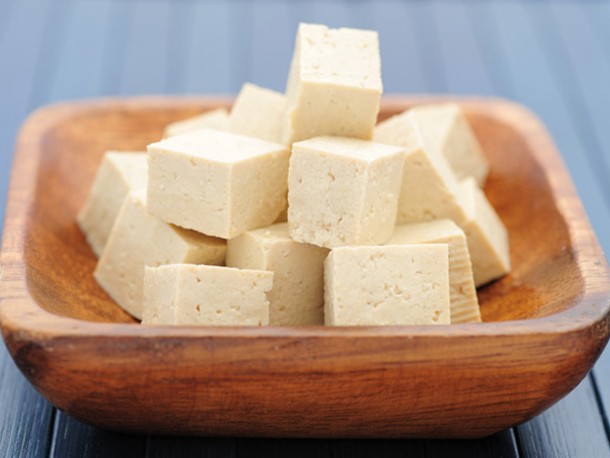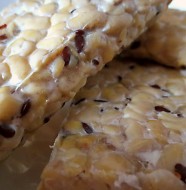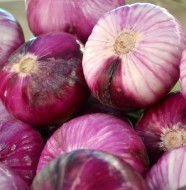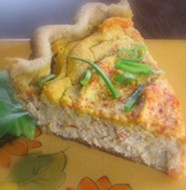Tofu belongs in your kitchen because it is power packed with protein, is amazingly versatile, has health benefits and can be inexpensive if you purchase it in the right places. We all can benefit from getting to know it better. Most of the people who claim that tofu “tastes funny” really mean that tofu doesn’t taste like anything they’re familiar with, or that it has no distinct flavor of its own and is really rather bland. They also mean that its texture is smooth and rather uninteresting. And all that is true. It is also why it is so very versatile and why it excites the inventive, adventurous cook in your vegetarian kitchen. Tofu begs you to play with it, be creative with it, have fun with it. It will go where you want it to go and do what you want it to do, picking up flavor and texture along the way.
Frequently people who have enjoyed meals prepared by a person who knows what to do with this marvelous food, don’t realize that they are eating tofu at all. They simply marvel at the wonderful flavors and textures of the meal and heap kudos on the terrific cook. You can trust me on this, I have been doing it for decades!
History and Use of Tofu
While growing in popularity in these United States recently, Tofu has been a staple in Asia for thousands of years. This amazing soy food was first crafted in about 164 B.C. by Lord Liu An, a famous Taoist vegetarian, philosopher and mystic. For more than 2000 years it has had a prominent place in Chinese cuisine. It reached Japan a thousand years later when Buddhist Monks crossed the China Sea. Being vegetarian, they introduced this wonderful soy food to the general public, popularizing it along with their Zen practice.
Made of soy ‘milk’, Tofu provides a source of inexpensive, readily available, easily digestible, high protein for vegetarians. Additionally, since it is bland and has no distinctive flavor of its own, it is remarkably versatile and lends itself easily to every part of the meal from appetizers, through soups, salads and salad dressings, to the entrees and finally — even the desserts. It can also be used to ‘bind’ other ingredients together as in Lentil Patties, Oat Burgers, or our Maryland Not Crab Cakes.
Tofu: A Variety of Textures
Tofu comes in a variety of textures, from extra firm, to firm to soft and silken. This designation is pretty much determined by its moisture content. Each has its own unique quality and uses in your vegetarian kitchen. These several varieties are not, however, interchangeable.
Extra Firm Tofu is a wonderful choice for recipes that require firm, well defined shapes like our Tofu Cutlets or Tex-Mex Love Boats; Firm Tofu works well in recipes that call for crumbling, like our Tofu Rancheros or No-Egg Salad; Soft Tofu is lovely in our Carrot Coriander Tofu Quiche, or deviled Tofu Eggs; and Silken Tofu is a superb choice for creamy vegan soups, salad dressings and desserts.
In other words, the texture of the tofu you select depends on what you want to do with it. If you are preparing a sauce or creamy soup, a dessert or salad dressing in your vegetarian kitchen use silken tofu. If you want to grill it, prepare cutlets, or some stuffed tofu like our Rock Cornish Game Stuffed Tofu, then you’ll select extra firm tofu. Soft tofu is great when you want to prepare Tofu Rancheros or Scrambled Tofu for Breakfast or Brunch. Tofu “No-Egg” Salad or our Luna Salad can be made with either soft or firm tofu.
Tofu becomes sponge-like and chewy when you freeze it. As it freezes it develops little channel-like tunnels which make it perfect to soak up a marinade or a barbeque sauce. In the interest of the presentation of your dish, it is best to cut the tofu into cubes before you freeze it, for then, as it thaws and as it cooks, it will retain its attractive shape.
Some companies have produced tofu which is already flavored for you, such as Nasoya’s Five Spice Tofu or their Garlic and Herb Tofu. In a pinch, when soft or silken tofu are not available, you can purée firm or extra firm tofu. However, the texture will be grainy and less than ideal. No matter which texture you choose to work with, in short order, you will find tofu to be one of the staple items in your vegetarian kitchen.
Savory Tofu Dishes
Savory tofu takes a bit more time to prepare than sweet tofu. If your savory recipe calls for high heat, as in grilling, roasting or barbeque, you will want to ‘toughen’ it up before you do that. Allow the extra firm tofu to drain for at least 2— 4 hours on kitchen towel covered cutting board which has been elevated at an angle by propping a shallow bowl under one end of it. Weight down the product with another cutting board on top. Put a pot lid, a heavy pot, or several china plates on top of that. This process removes any excess liquid and condenses the tofu making it even firmer.
A simple marinade of minced fresh garlic and ginger, finely sliced green onions, balsamic or rice wine vinegar, black pepper and sesame oil is a great favorite of ours here at Your Vegetarian Kitchen. It makes a quick and easy savory tofu. However, do not marinate it for more than a half hour. If you are using an acidic marinade, one that contains orange juice for example, you’ll want the tofu to soak for no more than 15 – 20 minutes or it will lose its texture and be more suitable for a sauce rather than for sautéing, grilling or baking. Teriyaki Sauce, Barbecue Sauce, Vinegar and Citrus Sauces all work perfectly as marinades with extra firm tofu.
Sweet Tofu Dishes
Blend silken tofu with fresh sweet berries, ( raspberries, blackberries, blueberries, strawberries etc.) some maple syrup or honey, and a sprinkle of powdered cardamom or ginger; and, depending on its consistency, you will have the basis of a fine fruit shake or smoothie, a “cream” pie, or a dessert sauce. Sweet silken or soft tofu can be served for breakfast or brunch as well. Simmer soft or silken tofu cubes in a broth of equal parts spring or RO water and sugar, and a sprinkle of powdered ginger, cardamom, or saffron. Cook on low heat until it has a syrupy texture. Serve in a pretty bowl. For an exotic touch add some organic Rose petals; or you can open a package of Chrysanthemum tea from the Chinese grocery store and sprinkle the flower petals on top of the broth. As it cools, sprinkle Rose Water or Orange Blossom Water into the bowl. Prepared this way, flavored tofu can be served warm as a “pudding” or used as a base for an exotic ‘sundae’ layered with warmed fruit, maple syrup, and chopped nuts. Or you can chill it and use it as a base for tofu “cheesecake” or a tofu cream pie.
As you can see Tofu provides an opportunity to be creative and have fun in your vegetarian kitchen. The possibilities are endless. Enjoy!
Where can I find it?
There are several commercial soy crafters producing tofu and other soy products from non GMO organic soybeans. A low cost form of high protein, you will find organic Tofu in your local health food stores in the refrigerated section, where prices range from $ .99 to $1.39 a package, while your Super Markets have priced the same package of tofu by the same soy crafter at $2.79. You will also find tofu available at Chinese, Korean and other ethnic grocery stores also for very low prices however; those products are generally not organic.
For even more wonderful information about this amazing food see William Shurtleff and Akiko Aogaki’s classic The Book of Tofu, which was first published in 1975 by Ballantine Books.





 Vegetarian. Instructor. Traveller.
Vegetarian. Instructor. Traveller. 

